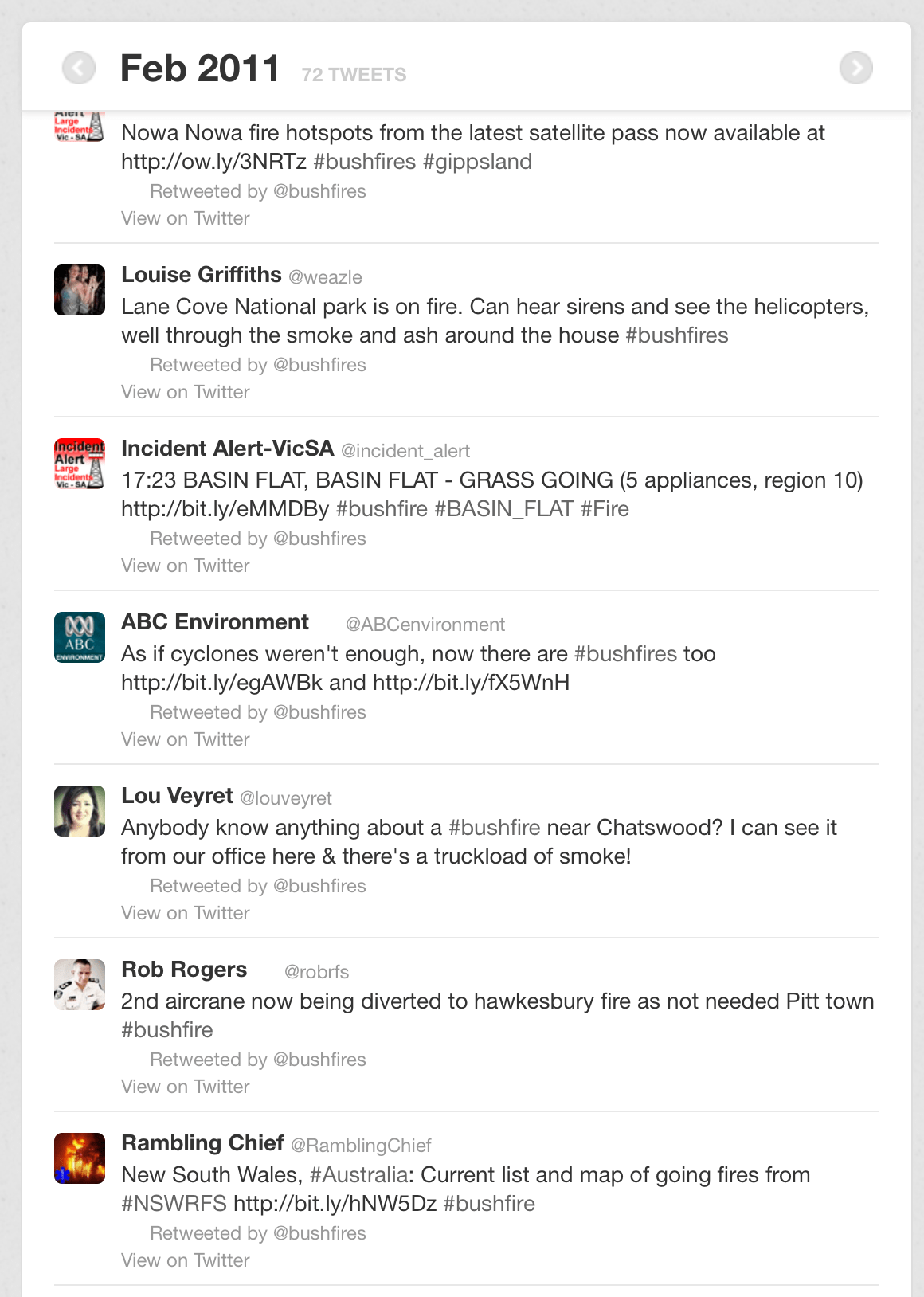On February 7, 2009 Victoria had the worst bushfires in the nation’s recorded history. Black Saturday, claimed 173 human lives and destroyed 2029 homes.1Black Saturday | Australian Broadcasting Corporation. I started the @bushfires Twitter account two days later.
For a bit of context, I’ll talk about Twitter in the ‘early days’. Twitter originally launched to the world in early 2006, with the first tweet being sent by the co-founder in March.
just setting up my twttr — Jack (@jack) March 21, 2006
I (@BeauGiles) joined in July 2007
Testing — Beau Giles (@BeauGiles) July 22, 2007
@Bushfires was created on the 9th Feb 2009.
Hey, I’ll be monitoring the latest tweets tagged with #bushfires and posting them here. Give me a sec to set it all up! 🙂 @BeauGiles — Bushfire Updates (@bushfires) February 9, 2009
Growing up in rural South Australia, bushfires were a realistic threat, moreso living out of the local township. Mobile reception didn’t exist at home, so any warnings would have to come from the radio, a phone call, or a knock on the door.
Being interested in technology and with ‘Twitter’ being the popular new thing back in 2009, it was great to see people and organisations making use of Twitter in more innovative ways. And I hoped I could add my 2c to make it easier for someone. Anyone. Hopefully.
Back in 2007, Twitter didn’t have ‘search’ anything like what it is today. ‘Track’ was introduced in September 2007, where you could ‘track’ a keyword via SMS, or over instant messaging.2Here’s a great blog post from 2007 after tracking ‘library‘ In 2008, Twitter improved things by acquiring a startup called Summize in July 2008. After the acquisition, Summize became Twitter Search and lived on it’s own domain at search.twitter.com. It wasn’t until mid-Feburary 2009 that search became slightly more integrated into your Twitter timeline.
In addition, Twitter had a lovely set of open APIs which was a free for all. It was incredibly easy to pull data from Twitter, including the search API. There was also no such thing as an ‘official’ or ‘native’ retweet until later in 2009, so there was the character limit to deal with, and other people ‘retweeting’ in their own ways. With Twitter ‘apps’ less than elegant for smartphones, and the website not making it easy to pull specific results out, I decided to see what I could do, and use the @bushfires account to share it.
In 2010, it was estimated that there were approximately 2.5 million Australians on Twitter.3https://web.archive.org/web/20100518110528/http://blog.tribalytic.com/2010/05/13/how-many-australian-twitter-users-are-there-and-where-are-they-from/ Most recently, Business QLD has stated that there are 2.9 million Australians on Twitter. 4https://www.business.qld.gov.au/business/running/marketing/online-marketing/using-twitter-to-market-your-business/who-uses-twitter Aleisha Orr, a reporter for WA Today, put together an article titled Twitter playing a role in #bushfire emergencies in 2013.
According to the Australian Bureau of Statistics half of all Australians had access to the internet on their mobile phone in June 2013. Social media platform Twitter, available via SMS and online, has proven its worth so well during emergencies that Western Australia’s Department of Fire and Emergency Services is considering using specially designed software that monitors eyewitness accounts on Twitter to map and respond to bushfires in WA.
This was one of the first ‘tweets’ from @bushfires:
RT @BigPondTeam Not sure how to prepare your home for #bushfire – check the CFS site http://twurl.nl/n7j5vh (CFS us… http://bit.ly/AZQU — Bushfire Updates (@bushfires) February 9, 2009
Originally, the tweets were less than ideal. They consisted of ‘RT @Username: Tweet with #hashtag. URL of Tweet’. This meant the retweet also contained the hashtag (adding to the feed).
Anyone with up-to-the-minute Churchill photos? #vicfires #bushfires #fireupdates(via @geehall1) http://twitter.com/geehall1/statuses/119 … — Bushfire Updates (@bushfires) February 9, 2009
I then played around with swapping the ‘RT’ for an (via @username) on the end of the tweet. The hashtags were still part of the retweeted tweet, however. (again, cluttering the feed).Twitter didn’t have it’s own URL shortener, so I needed to use a third party one. The biggest problem was dealing with the character limit; being able to show the important details, while still being able to credit the source.
I am planning a Fundraiser for those affected by the Victorian Bushfires. Please watch this space #bushfires (via @adamtoohey) http://tw … — Bushfire Updates (@bushfires) February 9, 2009
This tweet shared the whole retweet, shared who it was from; but had the original tweet URL truncated. Ideally, this should have simply been left off. Other later tweets simply were truncated, with the original Tweet URL always posted on the end.
RT @774melbourne: Residents in the vicinity of Thomson Road Area, Churchill are being told it is too late to leave … http://bit.ly/100ee — Bushfire Updates (@bushfires) February 9, 2009
Later, I stripped out the hashtags (so #bushfires became ‘bushfires’), avoiding adding duplicates to the feed.
now with 100% less hashtags. #bushfires, #vicfires and #fireupdates shouldn't be seen. 🙂 — Bushfire Updates (@bushfires) February 9, 2009
Current Melbourne temp 27.6 vicfires bushfires winds look around 20kp/h so far (via @geehall1) http://twitter.com/geehall1/statuses/125 … — Bushfire Updates (@bushfires) February 27, 2009
This was the best that could be done, and unfortunately some tweets ended up appearing a little odd without the hashtags, but the main message was there.
Major Fire Updates bushfires #nswfires http://tinyurl.com/98myrd (via @nswrfs) http://twitter.com/nswrfs/statuses/1287577506 — Bushfire Updates (@bushfires) March 7, 2009
Updated Bushfires Information Hotline 1800-240-667 vicfires bushfires (via @stephenedgar) http://twitter.com/stephenedgar/statuses/1268 … — Bushfire Updates (@bushfires) March 2, 2009
victorian schools to be closed tue due to vic bushfires at http://tinyurl.com/aowgwa (via @bushfires and @774melbourne) (via @webdotwiz) … — Bushfire Updates (@bushfires) March 2, 2009
Unfortunately, in the middle of all this; spam became a problem. With #bushfires and other related hashtags trending, bots started peddling their wares, using the hashtag and being retweeted by @Bushfires. By this time I had added a collection of search filters.
A tweet couldn’t start with RT. Tweets that started as a reply weren’t shown. Tweets that contained viagra/cialis/etc wouldn’t be retweeted.
—
Later in 2009, I tweaked the RT to simply wrap the username in brackets, to start the tweet (ensuring it wouldn’t be truncated). I believed that this would be enough to drop including the tweet URL in the tweet (which was usually truncated anyway.
(@rebeltalbert) Torrington bushfire SW of Tenterfield has broken containment lines. 6 homes may come under threat in next hour. — Bushfire Updates (@bushfires) November 30, 2009
(@rfsmedia) Fire near Torrington has broken containment lines. Abt 6 properties under threat. bushfires nswrfs — Bushfire Updates (@bushfires) November 30, 2009
(@rfsmedia) Difficult conditions with bushfires at Torrington and Bungawalbyn National Park. Check http://rfs.nsw.gov.au for updates. nswrfs — Bushfire Updates (@bushfires) November 30, 2009
(@gedulous) Houses destroyed, power out in Port Lincoln SA due to BushFires. Change is now through – temp & winds down, fire contained. — Bushfire Updates (@bushfires) December 23, 2009
(@A_View_From_Oz) A photo of today’s bush fire in Port Lincoln. http://tweetphoto.com/7006531 bushfire — Bushfire Updates (@bushfires) December 23, 2009
(@CollinVanUden) Choppers are on their way back to Mt Clear – just flew over my place (Wendouree) from the airport. bushfires — Bushfire Updates (@bushfires) December 31, 2009
It was in 2010 that Twitter started changing API requirements, while at the same time improving their website, and third party applications were also improving.
At the same time – more and more people were joining Twitter, and tweeting. There was a lot to take in and share if the @bushfires bot continued to republish all that was shared.
Search on twitter was improving, while users on Twitter were also following accounts more relevant to only them (e.g., RFS, CFA or CFS).
@bushfires made a brief return in early 2011, using the new native/official retweet functionality.
At this time, it was decided that @Bushfires wasn’t adding anything that wasn’t already available through third party applications or Twitter’s own search.
As such, the @bushfires bot has been left dormant.
Some of the first replies that were favorited by @bushfires;
Another great use of Twitter: @bushfires provides realtime bushfire updates — Grant (@grantshow) November 18, 2009
@BeauGiles you’ve done a fantastic job on @bushfires with the lists. It’ll be a great resource page this season. — George Hall (@geehall1) November 18, 2009
@BeauGiles by the way, good job today with @bushfires and @vicfires. Worked well. And the associated lists great references. — George Hall (@geehall1) November 19, 2009
In addition, @bushfires was also ‘identified’ in as a leading digital citizen for a #gov2au presentation.
Footnotes
- 1
- 2Here’s a great blog post from 2007 after tracking ‘library‘
- 3
- 4



